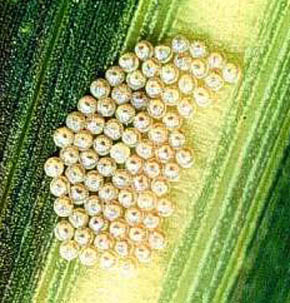
We have been
seeing reports in farm publications warning of the need to scout for Western Bean Cutworms
in corn fields. We see these insects to some
degree every year and I have been dismissing them as just an annual nuisance. However, I then heard rumors of massive counts of
Western Bean Moths in the area light traps and decided to check some of them out.
The most
impressive were the counts at Black Light Trap Aurora, Nebraska - Operated by Andrew
Christiansen, Extension Educator, University of Nebraska-Lincoln. Those counts totaled 1260 on July 6, 4160 on July
7 and 2750 on July 8. The trap at Adams
County reported 450 on July 7th and the Clay Center Ag Research Station
reported 250 on July 8th.
Farmers and crop
consultants need to begin to look for the white masses of western bean cutworm eggs in the
corn fields of central Nebraska. Female moths preferentially search out pre-tassel corn to
lay their eggs. These eggs are laid in clusters of five to 200 on the top surface of the
upper most leaf of a corn plant and on lower leaf surfaces of dry beans. The eggs require
five to seven days to develop, during which time the egg color changes to tan and then to
purple immediately before they hatch.
After the small,
dark brown larvae hatch on corn plants; they move to the whorl or tassel to feed on the
tender yellow leaf tissue or on the tassel itself. Once the tassel emerges or if it has
already emerged when the eggs hatch, the larvae will move to the green silks. The
developing larvae will feed on the green silks, moving down the silk channel until they
reach the ear tip. The larvae will feed in the ear tip until they are fully developed.
If the infestation on
one ear tip is so great that the larvae become crowded, a few individuals may move outside
the ear and begin to feed on the side of the ear. They will chew through the husks and
eventually begin to feed on the developing kernels, causing extensive damage.
Even though field
scouting for western bean cutworm in field corn should begin when the first moths are
caught, control decisions should be made shortly after the moth flight peaks. For central
Nebraska, that peak will probably occur around the end of the first full week of July
(July 8 to 12th).
When scouting
for western bean cutworms in corn, check 20 plants in at least five areas of each field.
Look for eggs on the top surface of the upper most leaf or look for larvae in the tassel,
leaf axil or ear tip. If 8% of field corn plants, 5% of seed corn plants or 5% of popcorn
plants have egg masses or larvae, consider applying an insecticide.
If an
insecticide treatment is warranted in corn fields, it should be made when 95% of the
plants in a field have tasseled. This timing of the application increases the chance that
the worms will be exposed to the insecticide resulting in better control. It is also
important to make insecticide applications before the larvae reach the silks. Once the
larvae reach the silk zone they quickly move to areas under the husks where they are more
protected from insecticide treatments.
It is important
to recognize that only Herculex™ I Bt corn hybrids, which contain the Cry 1F Bt gene,
would be expected to have efficacy against western bean cutworms. Other Bt hybrids contain
different Bt genes and do not have efficacy against western bean cutworms. They should be
scouted for western bean cutworms, and treated with an insecticide if threshold levels are
found.

University of Nebraska Cropwatch Photo